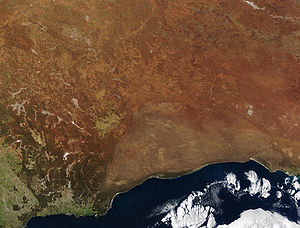Nullarbor Plain
Nullarbor Plain (Latin: nullus, "no", and arbor, "tree") is an area of flat, dry land in southern Australia on the coastline of the Great Australian Bight.


It is the world's largest single piece of limestone, and occupies an area of about 200,000 square kilometres (77,000 sq mi).[1] At its widest point, it stretches about 1,100 kilometres (684 mi) from east to west between South Australia (SA) and Western Australia (WA).
As to what causes these huge and distinctive limestone areas, no-one knows. Perhaps it is significant that one of the best-known area, the Yukatan, was in or near a hit by a huge meteorite. As much as 50% of the world's hydrocarbon reserves are in carbonate rock, and much of this is in porous karst systems.[2]
References
change- ↑ "Across the Nullarbor Plain". Kevin's Wilderness Journeys. 7 June 2004. Archived from the original on 10 October 2007.
- ↑ Ford, Derek 2007. Jovan Cvijić and the founding of karst geomorphology. Environmental Geology. 51 (5): 675–684.
Further reading
change- Bolam, Anthony Gladstone, 1893–1966. The trans-Australian wonderland Melbourne : Modern Printing, (many editions in the early 20th century)
- Edmonds, Jack 1976. Nullarbor crossing: with panorama photographs by Brian Gordon. Perth. West Australian Newspapers, Periodicals Division. ISBN 0-909699-09-7
Other websites
changeMedia related to Nullarbor Plain at Wikimedia Commons